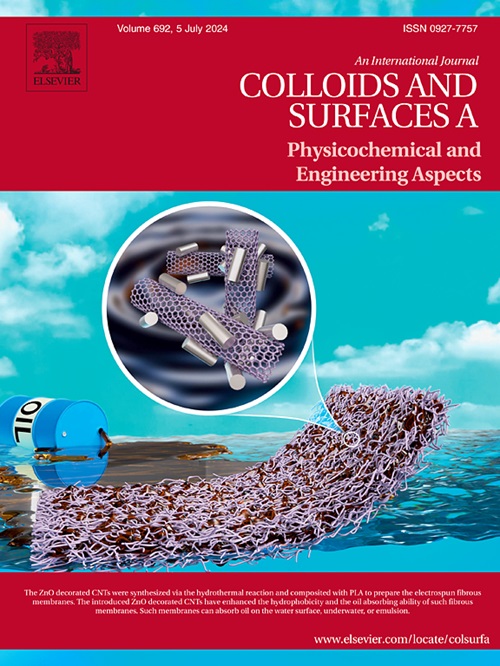The adsorption-photocatalytic cooperative mechanism for efficient degradation of methylene blue by SDBS modified ZnTi-LDH
IF 5.4
2区 化学
Q2 CHEMISTRY, PHYSICAL
Colloids and Surfaces A: Physicochemical and Engineering Aspects
Pub Date : 2025-07-16
DOI:10.1016/j.colsurfa.2025.137736
引用次数: 0
Abstract
With the development of global industry, the treatment technology of water pollutants has become increasingly important. In this paper, ZnTi-LDH photocatalysts with synergistic effects of adsorption and photocatalysis were synthesized by a simple hydrothermal method and applied to the removal of methylene blue (MB) from water. The synthesized ZnTi-LDH with sodium dodecyl benzene sulfonate (SDBS) modification (ZT-0.4) had improved adsorption and photocatalysis properties, thus greatly enhancing the removal rate of MB. ZT-0.4 was able to remove 98.1 % of MB in the static system and stabilized to remove about 76 % of MB in the dynamic system, both of which were substantially improved compared to unmodified ZnTi-LDH. Zeta potential analysis and Electrochemical tests indicated that the addition of SDBS enhanced the electrostatic adsorption capacity of ZnTi-LDH on MB, shortened the carrier transport path, and increased the electron-hole pair separation efficiency, which substantially improved the pollutant removal rate. The photocatalytic activity of ZT-0.4 remained a MB removal efficiency of 71.3 % after five consecutive cycles. ZT-0.4 also demonstrated enhanced removal rates for other dyes such as Rhodamine B (94.4 %) and Congo Red (100 %). Quenching experiment and electron paramagnetic resonance (EPR) indicate that ·OH, 1O2 and ·O2- radicals are the main active substances for photocatalytic degradation. In this work, efficient and stable ZnTi-LDH photocatalytic materials were developed by constructing an adsorption-photocatalytic synergistic mechanism, which provides a novel photocatalytic material design strategy for the dynamic removal of pollutants in wastewater.
SDBS改性ZnTi-LDH吸附-光催化协同降解亚甲基蓝机理研究
随着全球工业的发展,水污染物的处理技术变得越来越重要。本文采用简单的水热法合成了具有吸附和光催化协同作用的ZnTi-LDH光催化剂,并将其应用于水中亚甲基蓝(MB)的去除。经十二烷基苯磺酸钠(SDBS)改性(ZT-0.4)合成的ZnTi-LDH具有更好的吸附和光催化性能,从而大大提高了MB的去除率。ZT-0.4在静态体系中可脱除98.1% %的MB,在动态体系中可稳定脱除约76 %的MB,两者都比未改性的ZnTi-LDH有了很大的提高。Zeta电位分析和电化学测试表明,SDBS的加入增强了ZnTi-LDH在MB上的静电吸附能力,缩短了载流子输运路径,提高了电子-空穴对分离效率,大大提高了污染物去除率。ZT-0.4的光催化活性在连续5次循环后仍保持71.3 %的MB去除率。ZT-0.4对其他染料如罗丹明B(94.4 %)和刚果红(100 %)的去除率也有提高。猝灭实验和电子顺磁共振(EPR)结果表明,·OH、1O2和·O2-自由基是光催化降解的主要活性物质。本研究通过构建吸附-光催化协同机制,开发出高效稳定的ZnTi-LDH光催化材料,为动态去除废水中污染物提供了一种新的光催化材料设计策略。
本文章由计算机程序翻译,如有差异,请以英文原文为准。
求助全文
约1分钟内获得全文
求助全文
来源期刊
CiteScore
8.70
自引率
9.60%
发文量
2421
审稿时长
56 days
期刊介绍:
Colloids and Surfaces A: Physicochemical and Engineering Aspects is an international journal devoted to the science underlying applications of colloids and interfacial phenomena.
The journal aims at publishing high quality research papers featuring new materials or new insights into the role of colloid and interface science in (for example) food, energy, minerals processing, pharmaceuticals or the environment.

 求助内容:
求助内容: 应助结果提醒方式:
应助结果提醒方式:


